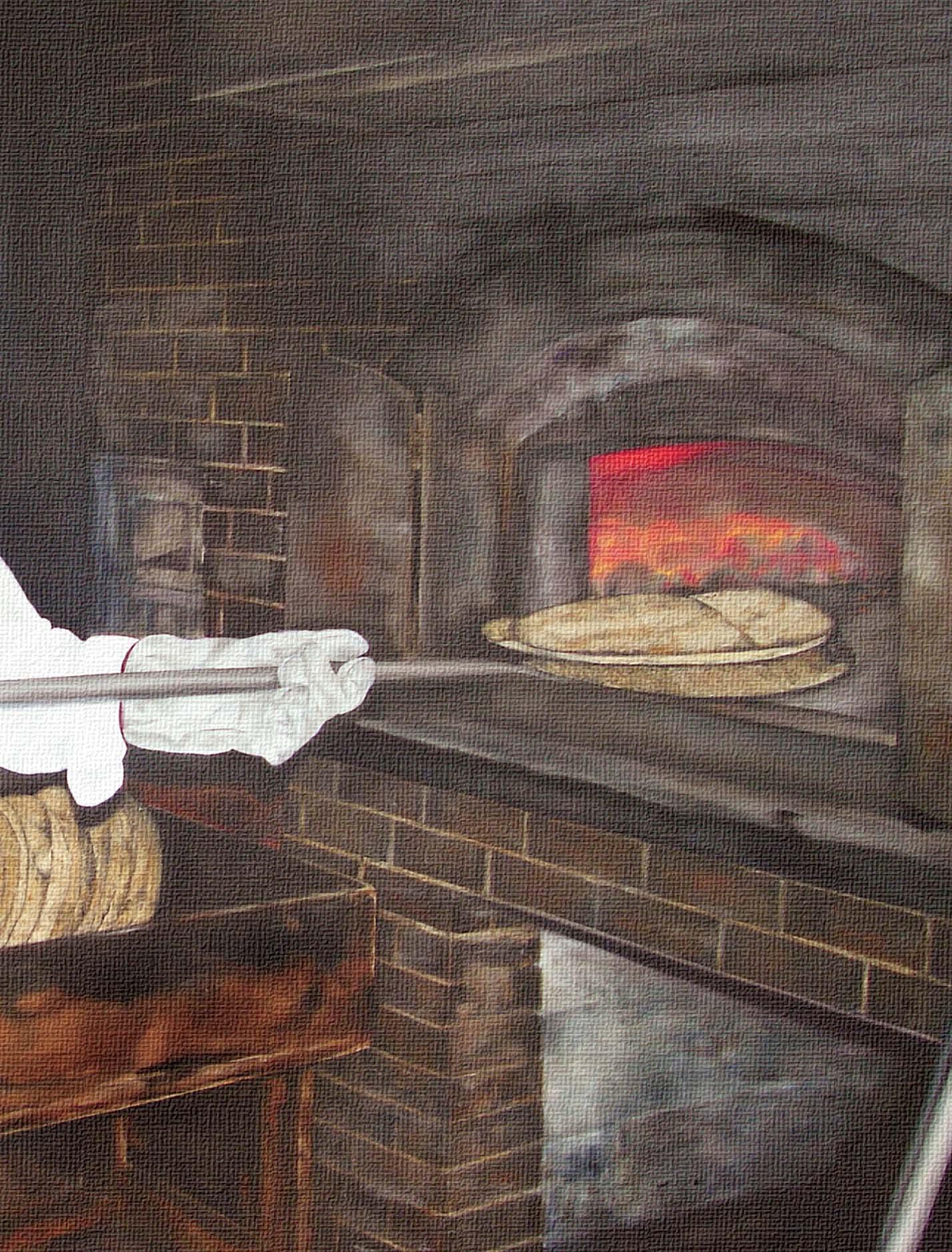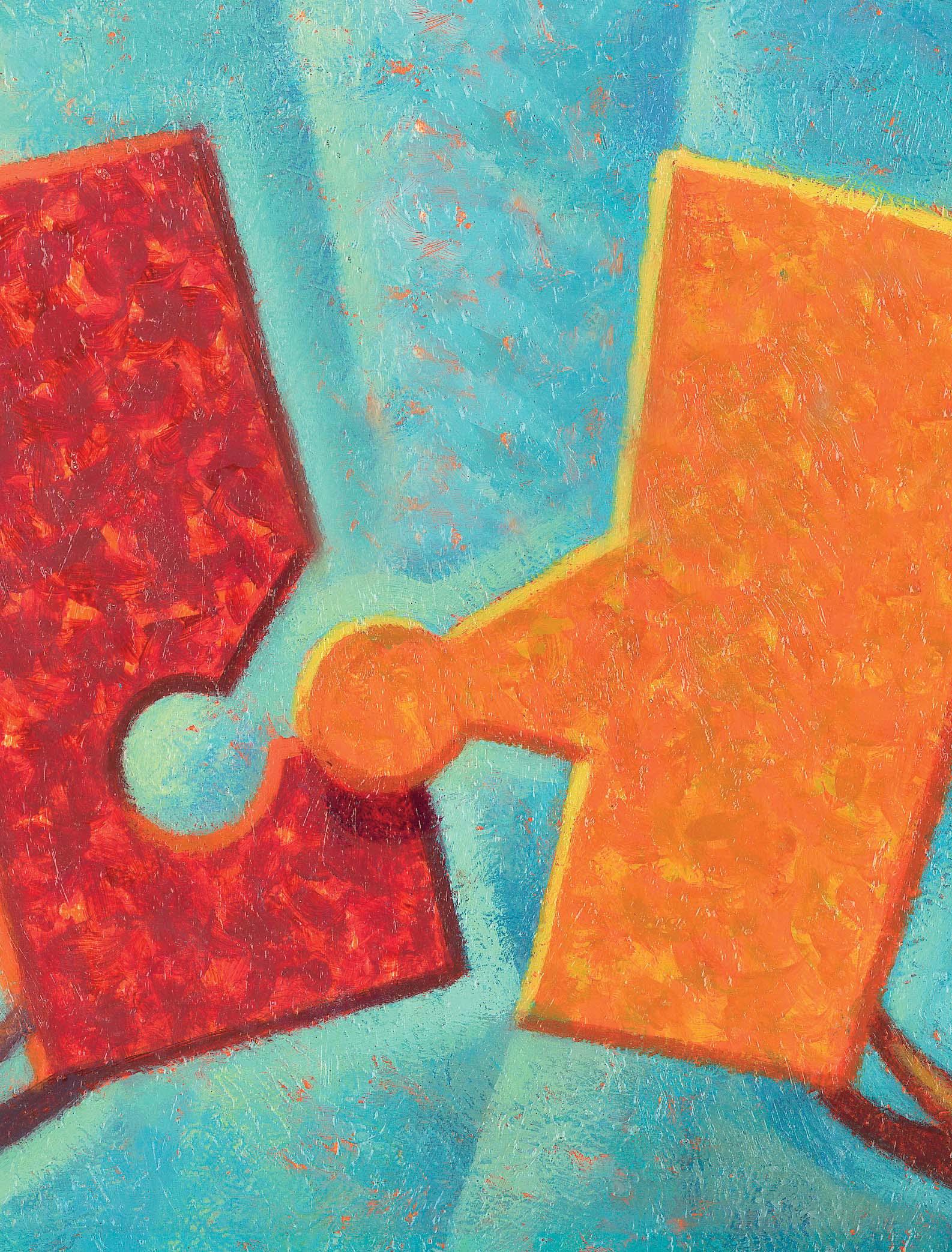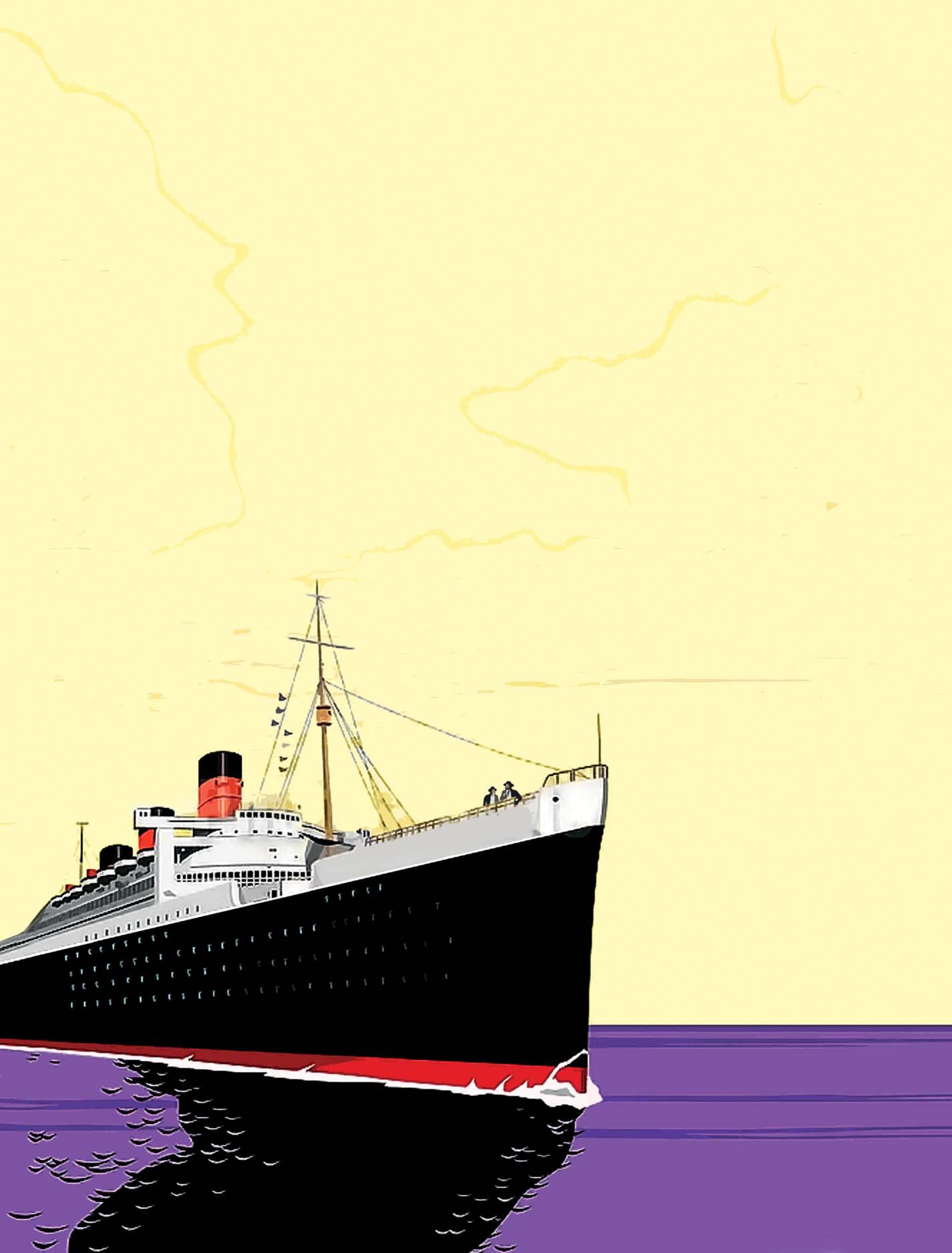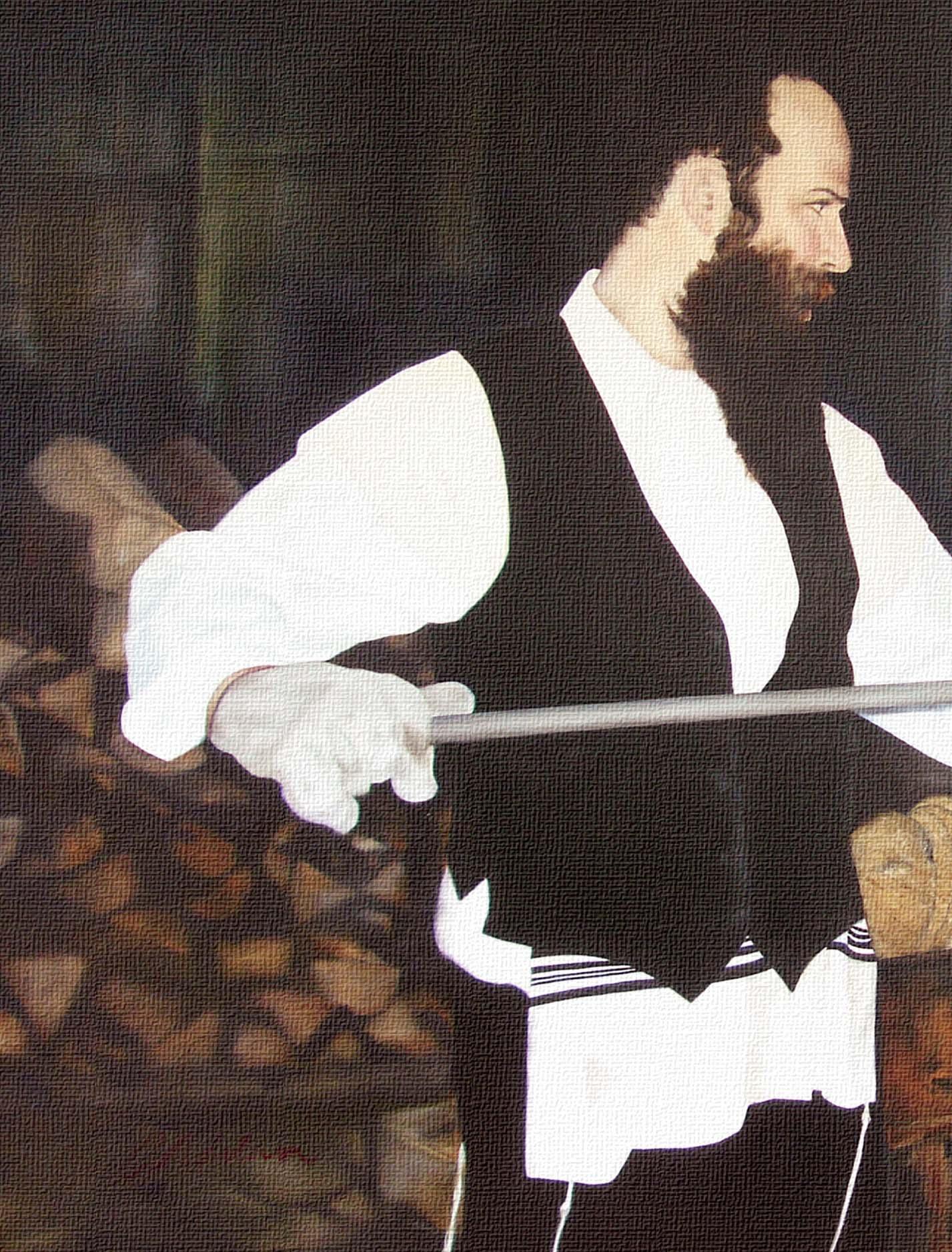FEATURED ARTICLE:
Electronic Formula Tracking at ~ Learn more about ~ Kosher Certification’s secret formula for maintaining the highest standard of kosher supervision.
Certified Soul Nutrition
DATE: Timeless

COST: Priceless
CIRCULATION: World’s Largest www.KosherSpirit.com
ccording to the Hebrew Bible, the Ten Commandments were engraved on two separate tablets. Why? Was God so short of granite that He needed to use two tablets instead of one?
The answer—proposed by Talmudic sages two thousand years ago—is astounding. The Ten Commandments, they suggested, were engraved on two tablets, five on each stone, so that they would be read in two directions—vertically and horizontally. Read vertically, they follow the well-known order. But read horizontally, Commandment No. 1 is followed directly by Commandment No. 6: “I am the Lord your God—You shall not murder.” History has proven that this juxtaposition is critical.

Two groups have made an attempt to divorce Commandment No. 1 from Commandment No. 6—to sever the idea of a Creator who conceived the world for a moral purpose from the imperative to honor the life of another human being. The first group were the philosophers of the Enlightenment; the second group were religious leaders in many and diverse ages. The result for both was moral defeat.

The End of Enlightenment
The thinkers of the Enlightenment ushered in the Age of Reason and the modern secular era, founded on the ethos that the great ideal of “You shall not murder” did not require the prerequisite of “I am the Lord Your God” in order to be sustained. Faith in God was unnecessary to ensure moral behavior; faith in man was enough—reason alone could guide humanity into an age of liberty and toward the achievement of moral greatness.
The Holocaust spelled the end of this faith in human progress based on human reason. In Auschwitz, the belief that modern man felt a natural empathy for others was forever vanquished.
The gas chambers were not invented by a primitive and illiterate people. On the contrary, this people excelled in sciences and the arts but nevertheless sent 1.5 million children and 4.5 million adults to their deaths solely because they were Jews. SS guards would spend a day in Auschwitz, gassing as many as 12,000 human beings, and then return home in the evening to pet their dogs and laugh with their wives. As the smoke of children ascended from the crematoriums, these charming romantics would enjoy good wine, beautiful women, and the moving music of Bach and Wagner. They murdered millions in the name of a developed ethic, and they justified genocide on purely rational grounds.
This is surely one of the legacies of Auschwitz. If morality is left to be determined exclusively by the human mind, it can become a morality that justifies the guillotine, the gulag, and the gas chamber. As Feodor Dostoevsky famously put it in The Brothers Karamazov: “Where there is no God, all is permitted.” Without God, we cannot objectively define any behavior as good or evil. No one can objectively claim that gassing a mother and her children is any more evil than killing a mouse. It is all a matter of
By Yosef Y. Jacobson
taste and opinion. The validity and effectiveness of “You shall not murder” can thus only be sustained when predicated on the foundation of faith in a moral Creator who gave humanity an absolute and unwavering definition of what constitutes good vs. evil.
Religious Evil
While the Enlightenment abandoned Commandment No. 1 in favor of No. 6, various religions over the ages abandoned No. 6 in favor of No. 1. Theirs has been the conviction that as long as you believe in the Lord, or in Allah, you can kill and maim whomever you brand an “infidel.” Whether it is a business
beLIeVE and let LIVE!
executive in New York or a teenager eating a slice of pizza in Jerusalem, if the person is not a member of your faith, God wants him or her to die. For the religious fundamentalist, “I am the Lord your God” has nothing to do with “You shall not murder.”
Yet a religion that does not inculcate its followers with the sanctity of every single human life erodes the very purpose of faith, which is to elevate the human person to a state beyond personal instinct and prejudice. If you delete “You shall not murder” from religion, you have detached yourself from “I am the Lord your God.”
The juxtaposition of the two commandments implies that you can’t believe in God and murder. Conversely, if you truly believe that taking the life of another human is wrong, not just because you lack the means or motive to do so or are afraid of ending up in jail, but because you recognize the transcendent, inviolable value of life, that’s just another way of saying you believe in God. For what confers upon human life its radical grace, its transcendent sanctity, and its absolute value if not the living presence of God imprinted on the face of the human person?
2| ~.org
Every so often, a complex question of Jewish law presented itself to Rabbi Pinchas Horowitz (1730-1805), the famed Rabbi of Frankfurt, Germany. The neighborhood butcher had brought before him a particularly complicated case. A defect had been discovered in the lung of a slaughtered ox, raising the possibility that it might be considered treif (non-kosher) and therefore forbidden for his Jewish community to eat.
It was a complex borderline case, and Rabbi Horowitz pored over the previous rulings of great Halachic authorities of past generations. Several rabbis had ruled the meat forbidden in such circumstances; others deemed it kosher for various reasons. Rabbi Horowitz immersed himself in the texts for hours. Finally drained and exhausted, he declared the meat to be kosher.

One of his students later approached the great Rabbi and asked, “Rabbi, why did you go to such lengths to render the ox kosher? After all, Rabbi Shabtai HaKohen (otherwise known as the Shach, a famed 17th century Halachic authority) deemed it treif. Wouldn’t it have been a better idea to just throw out the meat rather then being responsible for the violation of the kosher laws?”
Rabbi Horowitz smiled; these questions were not unexpected considering how controversial his ruling must have been.
“As you know, for every man there comes a day where he must stand before the heavenly court and account for his life. I imagine that, when that day comes for me, I shall have to defend the decision I arrived at today.
“The ‘prosecution’ will undoubtedly call a most prodigious witness to testify against me; Rabbi Shabtai HaKohen himself will probably testify that I permitted the eating of questionably kosher meat.
“I shall have to respond by citing the opinions of his lesser colleagues, who ruled that the ox was indeed kosher. I will also have to explain why I preferred their rulings over his. You can be sure that the prospect fills me with trepidation.
“But what if I had ruled that the meat is forbidden? Then I
By Sara Levy
would have to contend with another accuser, the ox itself. He will take the stand against me and bellow with rage: ‘How many hungry mouths might I have fed?’ He will cry, ‘How many hours of Torah study and prayer might I have sustained? How many good deeds might I have energized? This Rabbi standing here today discarded my meat, while there were grounds for rendering me kosher.’
“All things considered, I would rather take my chances against Rabbi Shabtai HaKohen, than confront a justifiably angry ox in court...”
SaraLevyisassociateeditorof KosherSpirit.
We welcome your comments, submissions, and letters to the editor. Mail: 391 Troy Avenue • Brooklyn, NY 11213 E-mail: editor@kosherspirit.com
Facing the Ox

EDITOR-IN-CHIEF: Dovi Scheiner
ASSOCIATE EDITOR: Sara Levy
KOSHER EDITOR: Rabbi Chaim Zalman Levy
EDITORIAL CONSULTANTS: Neria Cohen, Shalom Doron, Malka Percal DESIGN: www.SpotlightDesign.com
COVER ART: Gregory Gadilan Horowitz, www.gadilan.com
ORIGINAL PAINTING FOR SALE! Contact the artist at 917-435-1944, or ggh@gadilan.com
NOTE: The views of Kosher Spirit arenotnecessarilythoseofthe ~
We have the privilege of living in an era where no part of the world is too far for us to reach or communicate with, in spite of geographical or cultural differences.
Many things that make our Jewish way of life possible and enjoyable are the result of the collaboration of different companies located in different parts of the world. Items such as the kosher food we eat as well as many Judaica items we use in our daily practice are often manufactured in one corner of the world, assembled in another, and finally distributed in our own neighborhoods.
During the mid 20th century, Japan’s rise to become an economic superpower affected its influence on the kosher world. Currently, Japan produces some of the major food additives, health supplements, and basic raw materials necessary in kosher food production. Naturally, due to the differences in cultural and business mentalities, kosher
KosherJapan’sCulture
By Rabbi Hertsel Simantov
supervision in Japan is different from that in other parts of the world.
One of the main defining factors in Japanese society and business culture is the concept of hierarchy. This means that the work force is closely divided into segments with clear hierarchical boundaries. All aspects of businesses, and even simple work and social communications, are orchestrated by rules and customs. For example, when two Japanese meet, they exchange a Meishi, (a name card, rather than a business card). This will affirm the hierarchical relation of the two, and will then translate into who will greet/bow first, the degree of the bowing, who sits in the honoree position at the table, who is served first, etc.


Within this context, a visiting rabbi with the position of inspector/mashgiach automatically assumes a distinguished hierarchical position. The whole management team will accompany him
on his inspection, and it is highly likely that the company president or general director will make an effort to welcome the rabbi personally.
On the whole, there are two main objectives which kosher supervision emphasizes:
• to find production faults and expose kosher violations, and
• to support kosher production.
Although the chief aim of any kosher agency is to make sure the kosher status of a product is not compromised, the ramifications of these two attitudes are considerable in different parts of the world.
In some countries of the Orient, it is prudent to strive to find any delinquency in kosher control. In Japan, however, the supportive approach is more beneficial, as it is more likely to enlist the cooperation of the Japanese company in maintaining high kosher standards. The idea of any type of inspection puts
4| ~.org
Japanese administrators in a state of high stress and tension. Therefore, a rabbi’s inspection in itself carries great impact. With a supportive attitude, the rabbi can elicit administrators’ utmost cooperation, inducing them to overcome the language barrier, translate all the documents, and in a general way, be as transparent as possible.
As mentioned above, rules and regulations inform every aspect of Japanese behavior. However, in Japanese culture, there also exists what I call the “escape mode.” This allows the overseers to forgo for “one time” all the regulations and procedures. They use the excuse “special one-time case” to get away with breaking the rules.
Although Jewish law allows certain leniencies in select extremescenarios, in Japan it would be highly unadvisable to apply these leniencies. Once the Japanese become aware that such leniencies exist, it is quite possible that serious kosher violations could occur. In the 179 ~ Kosher certified plants in Japan, we instituted the highest kosher standards without relying on any leniencies, whether with regard to kosherization of complex machinery and productions lines, raw material, final productstorage standards or on-site full-time supervision. Our insistence that everything be run on the highest level of Jewish law is highly regarded, as it reflects the Japanese disposition toward scrupulous respect for law.
Moreover, it is common in Japan to find competing companies buying the same product from each other! This leads to a harmonious personal and business relationship despite their market-share competition. Naturally, Japanese companies would share with each other any deviation from the proclaimed kosher standard and procedure by their kosher supervisors—another reason why uncompromising standards of kosher supervision are essential in Japan.
One must be aware, too, of the fact that although many Japanese company personnel do speak English, they nevertheless speak Japanese-
English. This means that not everything they actually say in English is what they want to convey. In addition, they might understand the spoken English words but not necessarily their full meaning. The Japanese philosophy and language have an inherent tendency to be vague when defining a concrete reality. This leads to much confusion when foreigners try to communicate with Japanese and receive what sounds like a definite “Yes” or “No” answer from them.
The following samples of Japanglish will illustrate this phenomenon:

“No” can mean “Yes.”
“Sorry” can mean “Thank you.”
“It is difficult” means “No.”
“Maybe” means “Forget about it.”
As a case in point, I witness an incident overheard during my supervision travels. A foreigner at a Japanese airport requested to fly from point A to point B. The agent said, “It is very difficult.” The foreigner said he must make that flight. The agent said again, “It is very, very difficult.” The foreigner then asked, “Can you wait-list me?” Once more the agent said that it was difficult. The foreigner finally exclaimed, “What is so difficult about arranging a simple flight?” The agent replied meekly, “Sorry, but we do not have any flight between
these two cities…”
Our Rabbis teach us that during the Kingdom of Nimrod the unity of man was such that “nothing they planned to do will be unattainable for them” (Bereshit 11:6). Unfortunately, this unity was used to further man’s corrupt dominion over nature rather than to infuse G-dliness into creation. This caused the dispersion of man to the four corners of the world and brought about the destruction of unity of man.
In our era of globalization, we have the opportunity to try to recreate this unity. Our rabbinical work in the far corners of the world not only guarantees high-quality kosher food but also bestows on us the duty to be the emissaries of the Torah’s light, which ultimately will bring about the recognition of the Oneness of G-d.
~ Kosher| 5
Rabbi Hertsel Simantov is a Kosher Supervisorwiththe ~ Kosher Certification.
Since I began writing about the Tanya—Rabbi Schneur Zalman of Liadi’s revolutionary work on Hasidut from the late 18th century—I have been asked many times about the connection of Tanya to Kabbalah.
First of all, one must be cautioned that speaking about Kabbalah does not refer to the numerous imitations being sold nowadays in the form of little booklets, red strings, and healing waters. All of these approaches take the name of Kabbalah in vain, for the utmost secrets of the world and the promise of eternal life, protective angels, and supreme devotion cannot be purchased for five cents apiece. This type of commercialized mysticism is surely more propagated today than authentic Kabbalah and has the dangerous ability to deceive the masses into believing that they have discovered the essence of Kabbalah.
Kabbalah is—or at least has been for the last 500 years—the official theology of the Jewish people. It is the route to gaining a better understanding of the relationship between man and God. Anyone who feels any sort of connection to G-d should have enough sense to be interested in knowing G-d. This is true about so many other things; for instance, if I love or admire somebody, I have a desire to know that person better and in a deeper, more intimate way.
As a genre of literature, Tanya is what one may call “applied Kabbalah.” It is not a pure theological statement rather, it is Kabbalah as applied to the problems of the
MANOF WAR
human psyche and of human life.
The Tanya is clearly a book about morals and morality, a guide for those trying to find a way to reach higher and to become more refined spiritual beings. It is a story of war, the eternal—or at least, the very consistent battle raging within every human being. In this story, the person himself is not the actor; he is the battlefield.
In studying this struggle, it is of course important to identify the parties at war: What are these facets of man that are engaged in constant battle? Interestingly enough, the Tanya does not define the two sides as good and evil, nor as body vs. spirit. Instead, the Tanya calls it a war between two souls: the animal soul against the Divine soul, both of which reside in the heart of man.
Man is basically a materialistic, animalistic creature, but he is also created from a Divine mold. These two sides of humanity clash constantly over the question of identity: Who am I, and how can I be defined? Tanya seeks to clarify for its readers the distinction between the animal and Divine parts of man and to explain why they are in intrinsic—and unending—disagreement with one another.
In this book, the animal soul does not have the base definition that often comes to mind. The Tanya does not view the animal as the domain of the so-called carnal desires or physical needs. Rather, it speaks about the self, that level of man that views itself as the beginning of everything. No creature of zoology can
By Rabbi Adin Steinsaltz
really think about anything without using itself as a starting point: I exist, I am the center of everything, I am the purpose of everything, and from here I go on. The essence of man’s purpose is this struggle to get out of the self, to break free of his animalistic confines in order to connect with the Divine.

While the description of this battle within each human being is an important part of the book, the Tanya also tries to devise strategies to help people win this war. It teaches how one can do better and how one can give the side of the “good” some power to effectively overcome its opponent.
The study of Tanya is a demanding one, but it is perhaps one of the most approachable means to Kabbalah. Like many other pieces of Hasidic literature, the Tanya has taken some of the most grand and abstract notions of the world and put them in such a way that they become meaningful in life. In a very practical way, this book offers those seeking a more spiritual existence the formulas by which they can better know God, and better know themselves.
Rabbi Adin Steinsaltz is an author, scholar, and social critic best known for his monumental translation and commentary on the Talmud. He is also the founder of a worldwide network of Jewish educational institutions, which are supported by the Aleph Society. For more information about Rabbi Steinsaltz’s work, visit www.steinsaltz.org.
Ideas from this essay are expounded upon in Rabbi Steinsaltz’s most recent book, Learning From the Tanya: Volume Two in the Definitive Commentary on the Moral and Mystical Teachings of a Classic Work of Kabbalah (Jossey-Bass, 2005).
6| ~.org
from dishwashers to microwaves to automatic coffee-brewers, technology has revolutionized the modern kitchen. The timeand energy-saving devices are no doubt a boon, given today’s hectic lifestyle. Yet for the kosher consumer, every new technology introduced brings with it a host of halachic concerns: According to Jewish law, may I kosherize my dishwasher? May I kosherize the microwave betweenmilk and meat?
The wonders of technology have had a similarly revolutionizing effect on the commercial scale. Some procedures are advantageous to kosher supervision, enhancing the ease with which ingredients can be tracked, for example. At times, though, the technologies present kosher challenges, and the supervision agencies must find ways to work around them. This is what we refer to as “technological tension”— appreciating the benefits of modern technology while seeking creative ways to make them compatible with kosher observance.

TECHNOLOGICAL Tension
By Rabbi Yitzchak Hanoka
kosher products as well. Steam is also used to thaw out drums of ingredients that may have congealed during transport, due to cold weather or the like. The tub is dipped into a steam bath, which warms it back up to room temperature. The same steam bath might beused repeatedly for many different ingredients, including non-kosher ones. The resulting kosher challenge can be worked around by dedicating one steam bath exclusively for kosher use. Another way of solving the problem is by enclosing the drum in a thick, nonporous bag. The bag acts as a wall separating between the food drum and the steam bath, which may have absorbed a nonkosher taste from a previous tub.The above process is monitored by an expert kosher supervisor.
A modern food-production plant now produces a vast variety of products, using ingredients originating from all over the world. Gone are the days when products were processed and packaged close to where the ingredients were grown. Many ingredients are now reduced to concentrate form and then shipped to bottling plants located closer to the end user—the shopping centers and grocery stores that will carry the product. This saves on transportation costs, as ingredients in concentrate weigh up to three times less than at full strength. In kosher terms, though, this means that one bottling plant may be processing hundreds of different products on the same equipment. The same machine might be bottling orange juice one day and clam juice the next. The kosher agency must supervise each plant closely to monitor what is being produced on every given piece of equipment to ensure kosher compliance.
New technologies are available to improve energy efficiency, which can translate into savings of millions of dollars. One way that commercial food processors save money during production is through a process called steam return. First, the food is cooked by heating it with steam pipes. After use, the steam is returned to the main boiler. This way, the heat in the steam is conserved, and the boiler does not have to heat up a huge volume of cold water for every run. From a kosher perspective, though, the steam that was used to process a non-kosher product cannot be recycled to cook kosher products. The problem can be solved by adding an ingredient to the steam to make it non-palatable and unfit for human consumption. This ingredient has no effect on the taste of the food itself, as the steam does not come in contact with the actual product. However, this small step eliminates the kosher concern and allows this energy-saving technology to be used on
Of course, technology does not exist only to create annoyances for kosher supervisors. Many technologies actually make the job of kosher supervision much simpler. One very common piece of equipment in food production is the spray dryer, which converts liquids into powdered form. A special computer attached to the machine, called a Honeywell Chart, keeps a detailed history of when the machine was turned on, at what temperature, and for how long it ran. Before a machine can be koshered, a 24-hour down time is required, during which it is not used. The Honeywell Chart provides a very reliable record of when and how the machine was last used. This helps verify when the equipment is down for 24 hours, so that the kosherizing process can be carried out according to procedure.
Thanks to the advance of computer technology, plants now have up-to-the minute records of the ingredients used in any given production. This serves the purposes of the company, which must carefully track any potential allergens or other unsafe ingredients. Kosher supervision is a direct beneficiary of this technology. In the event that an ingredient suddenly loses its supervision, it is now feasible to immediately follow up on which products contain that ingredient and make the necessary change.
Overall, the “marriage” between modern technology and kosher observance has been a positive one. By applying innovative solutions, we are able to derive full benefit from technological advances while not compromising our kosher standards. Jewish philosophy elaborates on the concept that everything in the world can be utilized and elevated for a G-dly purpose. At ~ Kosher Certification, it is our job to stay informed of new developments in technology. We can then utilize these technologies, thereby “elevating” them by using them for the sake of a mitzvah.
~ Kosher| 7
Rabbi Yitzchak Hanoka is a Rabbinic Coordinator with the ~ Kosher Certification.
By Chaim Zalman Levy

Charlie and the Candy Factory
Charlie B. is a production manager on the factory floor at the D-lish Confection Company, producing fine New England candies from family recipes that go back over a hundred years. Charlie works closely with the Kosher supervisor, Rabbi Z., to make sure that all of D-lish’s candies can be certified “Kosher parve”—Kosher candies that can be eaten after both meat and milk dishes. Working from the secret Dlish formulas, Charlie prepares a Master Ingredient List from which Rabbi Z. verifies the Kosher status of all the components that go into D-Lish candies.
Year after year, the very same products come off the lines at Charlie’s candy factory. With no meat or milk products to watch, Rabbi Z.’s intermittent spot checks are enough to ensure D-Lish’s Kosher standards, and he knows that he can trust Charlie to apprise him of any changes—in ingredients or suppliers—that might affect the factory’s status.
Charlie is thorough, and his Master Ingredient List includes every component used year-round at D-lish. So it took them both by unpleasant surprise when, one gray November day, Rabbi Z.’s spot check uncovered a product whose ingredients had never made it to Charlie’s master list. What happened?
Each year, for one week in November, D-lish produces a seasonal confection, Mister Kringle’s Soft Kandy Kane. It’s a short run on only one production line of many. The problem? The master list doesn’t include ingredients not used in standard production. In fact, the Soft Kandy Kane had only one minor component that wasn’t already on the master list anyway. Unbeknownst to Charlie, however, the “one minor component”— gelatin from a non-Kosher animal source—jeopardized the Kosher status of an entire production line. Who knows how many “Kosher parve” candies had been neither “Kosher” nor “parve” over the years?
8| ~.org
This is the first in series of articles highlighting innovative approaches by ~ Kosher to ensure the highest quality standards in Kosher Supervision.
Fictional Situation, Factual Problems
Fortunately for Charlie, Rabbi Z., and thousands of Kosher consumers, the “Dlish Confection Company” and its mismarked “Kosher parve” candies are fictitious. But the potential for such a scenario—in which a single non-Kosher ingredient can compromise dozens, hundreds, or even thousands of products—lurks inevitably behind the scenes in factories under traditional Kosher supervision. And while a modern facility might catalog its product ingredients in a computerized database, when a change takes place—a meat, dairy, or even non-Kosher ingredient enters the picture—it remains almost impossible to track the problem through the entire production system to find the affected products and update their Kosher certification.
The Solution: KCert Formula Tracking from Kashrus.com
Enter Kashrus.com and its comprehensive program, which marshals the power of cyber-age technologies to raise the bar on Kosher supervision. With its KCert Formula Tracking program, Kashrus.com has created Kosher-specific database software that permits the supervising agency to keep an accurate, up-to-date inventory of every ingredient and track all of the formulas in the plants they oversee. Without tracking formulas, even a company with a computerized database will not be able to find all the applications of a new ingredient, or one whose status has changed. With Kashrus.com’s program, it is possible to instantaneously find every product that is affected by any new development in the company’s ingredients. Further, the entire database is cross-ref-
Of Batch Cards and Master Lists
To ensure quality standards and consistency, every item produced in a modern food facility—from industrial flavorings to finished retail products—is made from a consistent formula that includes all the ingredients used in its production. In food industry parlance, these specific formulas are known as “Batch Cards,” and it is from them that the factory will produce a Master Ingredient List that contains, as its name implies, all of the ingredients used in the facility. Standard procedure for Kosher supervision has been—and remains, for agencies not yet using digital formula tracking—to monitor components from the Master Ingredient List. In the early years of industrial Kosher supervision, this may have been sufficient; but in the dynamic environment of modern industry, without real-time tracking of specific formulas—the Batch Cards—it is easy to miss changes that can significantly affect the Kosher status of production items.
erenced, so that a single change can be traced throughout all of the companies under the agency’s supervision.

~ Kosher puts KCert to Work
Necessity is the mother of invention, and like most important innovations, Kashrus.com’s drive to develop KCert Formula Tracking came from the practical concerns and real-world experience in the field of Kosher supervision. “Probably,” “most likely,” or even “almost definitely Kosher” have never been sufficient standards for Rabbi Don Yoel Levy and his staff of rabbinical supervisors at ~ Kosher, and the difficulty in tracking ingredient changes was a glaring problem that demanded their attention. In response to ~ Kosher’s desire to provide supervision of uncompromising quality, Kashrus.com developed and perfected the KCert program that ~ Kosher now uses to track the formulas for every company under its supervision.
~ Kosher has spared no expense in time, manpower, or financial investment to develop an infrastructure that ensures the consumer that the food products under its supervision are 100% Kosher, exactly as marked. Obviously, no system is foolproof, but formula tracking adds invaluable levels of safeguarding to Kosher supervision. Thanks to the computerized database, on a daily basis the ~ prevents mistakes and inconsistencies that could have adversely affected the Kosher status of the products, even in an all-Kosher factory. (See sidebar, “Proactive and Reactive Supervision.”)
And D-lish Confections? With a strict requirement (like the ~'s) of obtaining formulas for all products, even in an allkosher factory, and a policy of having the supervising Rabbi cross check the production log and actual batch card to
A New Era of Technology
A step ahead of the curve, well over a decade ago, ~ Kosher recognized the advantages that computer technology could bring to Kosher supervision. In 1992, ~’s nascent Information Technology department started to develop its first system; within five years, ~ Kosher began to issue Kosher certificates based solely on formulas transferred through the system. All client companies (with no “grandfathering,” a common practice exempting long-term clients from newly instituted standards) were asked to provide complete, current formulas for all products receiving ~ certification—a major step toward the world’s first comprehensive Kosher database. Leaning on the know-how gained from ~ Kosher’s pioneering work in the ’90s, Kashrus.com was founded in 2000, with developers experienced in the ~ system. The relationship was symbiotic. In 2003, the ~ replaced its system with the new KCert software developed by Kashrus.com. In general, software development has a success rate of only 30 percent, but with a team tweaking and testing its applications in a practical environment for more than a decade, Kashrus.com continued its string of successes with the launch of the Digital Kosher service for supervised companies in 2004.

~ Kosher| 9
ensure that all information was properly sent in, Rabbi Z.’s supervising agency would have discovered the non-kosher animal gelatin just minutes after Charlie submitted his factory’s formulas. Rabbi Z. would have known to kosherize the line. Or better yet, D-lish could have found a substitute ingredient well in advance, thereby keeping all the factory’s products kosher as marked.
Win/Win/Win: Kashrus.com, KCert, and Digital Kosher
In designing its computerized formula tracking system, Kashrus.com was concerned first and foremost with the supervising agencies and their responsibility to the consumer to assure the integrity of Kosher products. But while KCert helps agencies such as ~ Kosher keep track of formulas, how would the supervised companies keep up with the increased demand for information? Kashrus.com has interlinked with a separate service— Digital Kosher—that completely streamlines formula submission for the supervised company and allows it to obtain necessary paperwork quickly and easily. Information can be submitted electronically, and if any questions do arise, the company can receive answers within minutes. And there are substantial benefits: Digital Kosher offers the company a more accurate, real-time view of its production, allowing more exacting quality control that acts as a safeguard against liability for mislabeled products—and multimillion-dollar lawsuits.
Electronic Formula Tracking: Part of the Big Picture at ~ Kosher



Electronic formula tracking is only one of the many ways that ~ Kosher sets the pace in providing the highest standards currently available in Kosher supervision. As food science advances and the Kosher market continues to grow, ~ Kosher will continue to explore new means to use technology to expand and improve its services on behalf of consumers and food producers.
ChaimZalmanLevyisKoshereditorofKosherSpirit.
The ~ Formula Tracking Team
Although only a few supervising agencies have joined in taking the step forward, digital formula tracking has rapidly become an indispensable and integral part of industrial food supervision at ~ Kosher. At its own expense— with no other benefit than improved supervision—~ Kosher employs a team of ten full-time staff members who collect formula information and check all ingredients. A dedicated rabbinic supervisor, with graduate-level training in food science, reviews each formula for missing ingredients and inconsistencies. Periodic reviews of company information constantly reinforce the accuracy of the system. Closing the loop is ~ Kosher’s network of hundreds of on-site supervisors who make sure that the ingredients used in the factory are exactly those submitted to the ~ system.
Proactive and Reactive Kosher Supervision
“Kosher supervision is both proactive and reactive,” says Rabbi Levi Garelik, an ~ senior rabbinical supervisor. “From the outset, the digital system allows us to know precisely what’s in the factory and to set up our supervision accordingly—proactively preventing any problems if we’d failed to accurately catalog all ingredients used in production. No question, it’s a quantum leap in assuring the consumer that products are Kosher just as marked—‘parve,’ ‘dairy,’ etc.,” he says. “It allows us to see at a glance all the details of a facility—with unparalleled precision—and really ‘oversee’ production to make sure it’s Kosher.” But there is another side to supervision. “It’s not only ‘up front,’ though—it helps us reactively as well,” Garelik explains. “Let me give you an example: Suppose that out of its hundreds of products—all ‘Kosher parve,’ let’s say, a flavor company uses a certain ingredient in only a few of the flavors it produces. One day, the company receives a notice from the supplier telling them that this ingredient wasn’t ‘parve’—it was ‘dairy’! To keep the plant ‘parve,’ we have to know where it was used. Which products were affected? If you have formulas, it’s very easy to pinpoint the problem exactly; without formulas, though, you have to initiate an investigation that will cost time and money. And you may still not be sure that you’ve found every place.”
Have your computers contact my computers…
In its ongoing efforts to eliminate the potential for error in Kosher supervision, ~ Kosher works hard to encourage its client companies to use their own computer systems to generate the formulas necessary for the ~ system—and send the information directly to the ~ computers. Every factory has a recorded profile, and the ~ system immediately detects ingredients which are inappropriate according to the factory’s profile. Within minutes of receiving the information from the company, any causes for concern can be checked—and rectified by ~ Kosher’s headquarters staff and on-site supervisors.
10| ~.org
By Ruth Benjamin
he Queen Mary cut her way through the waters of the Atlantic, hardly using her potential speed of over 28 knots. The great steamship that had made her maiden voyage just over a year ago was the finest ship in existence. Her parlor suites far surpassed the splendor and comfort of the finest of hotels. Her first-class section was the ultimate in luxury, and even her third-class section was very comfortable.
The year was 1937. Who could have imagined that in just over two years’ time, the 2,000 portholes would be blackened by the crew members hours before war was declared? Who would imagine that the magnificent Queen Mary would soon serve as a troopship, her capacity leaping from 1,997 passengers and 1,174 crew to 9,880 troops and 875 crew, more than 10,000 people?

In 1937, who would have believed this? True, there were rumors of war and of a sadistic despot in Germany, and of bitter and violent anti-Semitism. True, many people, especially Jews, were trying to leave Europe at any cost. But the horrific reality of what was to happen was not yet felt or even thought of.
The ship sailed with her passengers from New York to Southampton, England, for its five-day journey.
Two young men, or rather
teenagers, were conspicuous among the passengers. Initially, it was their long peyos (sidelocks that hung down their cheeks) and Hassidic garb that struck the other passengers. Later, it was their difference in behavior and the time they spent in prayer. They were en route to their Rebbe—the previous Lubavitcher Rebbe, Rabbi Yosef Yitzchak Schneerson, in Otwotsk, Poland—to study in Yeshiva. As the journey progressed, their enthusiasm increased.
One of these boys was Berel Levy. Though only 15 years old, he already had a deep commitment to Torah study and an intensity in prayer that permeated his whole being. In fact, as he himself records in 1970, writing about these times, these prayers became more enthusiastic and lengthier as the ship drew nearer to the shores of England. He notes of this time: “That great country aroused not a flicker of interest in me. As far as I was concerned, it was a minor stopover on the major road to Otwotsk.“
Berel had spent the last few years with his uncle, an extremely devout and brilliant man known as Reb Avrohom Ber, the Malach (the Angel). The Malach was known for not compromising one iota of what was right and true according to the Torah. Berel had imbibed that spirit, and his
WhileShapingShipping
clear brown eyes showed a depth and intensity far beyond his years.
There were many Jews on the ship, among them prominent community and Zionist leaders en route to the World Zionist Congress in Europe. As time went on, they engaged the two boys in conversation. One of these people, the editor of one of the largest Jewish newspapers in New York, one day boasted to the boys that it was at least 40 years since he had last put on tefillin.
The boys reacted immediately, telling the editor in utterly sincere but no uncertain terms that such things were not to be boasted about. A prominent religious Zionist leader standing nearby began to scold the boys for their rudeness to the editor. He could scarcely cover up his embarrassment about the insult to his nonreligious colleague.
However the editor had been struck by the pure sincerity of the rebuke. “They are right,” he said. “They are truly religious Jews. They should speak as they did to those who willfully disobey the commandments, rather than flatter us as you and your friends do.”
The religious Zionist leader was overwhelmed with a different kind of embarrassment, and he quietly moved on.
The editor had appreciated the directness, sincerity, and uncompromising stance of Berel Levy and his companion, a stance which Berel was to maintain for his whole lifetime. For decades thereafter, as father of ~ Kosher Certification and a leading figure in the world of kosher supervision, his winning personality coupled with an obvious commitment and sincerity would melt the resistance of Jews (religious and secular) and non-Jews alike. His life was dedicated to the spreading of uncompromised, pure, and undiluted Torah law and values.
RuthBenjaminisaclinicalpsychologist, universitylecturer,andprolificauthor. ShelivesinJohannesburg,SouthAfrica.
~ Kosher| 11
Each year, many Jewish families sit at the seder table, partake of the nostalgic, symbolic foods, enjoy the cups of sweet wine, recite the historic words of the Haggadah, listen to the familiar sound and rhythm of the youngest child reciting the Mah Nishtanah (Four Questions), and relish the delicious meal. Passover is indeed a family celebration, and no one should celebrate the holiday alone. The experience of Pesach is essentially family oriented.
During Pesach, there is no individual “I,” but rather the plural, “We.” Together, we experienced the bitterness of slavery in Egypt, we witnessed the miraculous deliverance from slavery, and we tasted the fruits of freedom. However, one of the hidden and ignored messages of Pesach is the importance of remembering that we are one family and one people. As we suffered and experienced together both the bitterness and the sweetness, we should always remember that as one family we should always care for each other, help each other, and certainly hear the cry of a fellow Jew in need. After all, we are family and all Jews are one family!
My family lived in Japan for many years, where I was asked by the Lubavitcher Rebbe to serve as the rabbi of the Jewish Community of Japan. When living in Tokyo, I researched the history of the Jewish experience in Asia, from India to
Japan and was enthralled by the fascinating but little-known exotic experience of the Chinese Jews.
Jews came to China from Persia on the Silk Road, about 1000 years ago. They were very warmly received by the Emperor and were invited to live near the imperial palace, in the capital city of Kaifeng. The Emperor requested that the Jews keep their ancestral traditions and be an asset to China. They lived as faithful Jews and observed a Jewish way of life. They built a magnificent synagogue, the Temple of Purity and Truth, which was Chinese in style and Jewish in content. It had a prayer hall, mikveh, yahrzeit chapel, and many Torah scrolls. The street of the synagogue, to this very day, is still called Teaching Torah Lane South, and as a courtesy and gesture of respect, the Chinese did not carry pork on the street of the synagogue. Rabbis trained their sons to be rabbis, and they kept community records and produced prayer books and Hebrew school textbooks.
With the passing of time, the open and flourishing China closed its borders, and the local Jews lost all contact with the outside world. The synagogue was destroyed by floods and local wars, and had to be rebuilt several times. Sons of rabbis frequently took more lucrative and prestigious positions, and the Jewish community declined, intermarried, and assimilated.
In June of 1605, in Beijing (about 500 miles from Kaifeng), there was a humorous confrontation of major historic importance. A 60-yearold
Chinese man, with a Chinese-Jewish family name of Ai, knocked on the door of a recently arrived Jesuit missionary, Fra Matteo Ricci. Ai heard that in Beijing, there was a man who believed in the one G-d, denied being a Muslim, believed in the holy way of life, and since Ai had never heard of Christians, he assumed that this European foreigner was a Jewish rabbi. When Ai was met at the door, he announced that he came to pay his respects, tell of his congregation, and meet his fellow co-religionists. Ai was anxious to contact his fellow Jews and create a new chapter in their history. He was surprised to see the images in the chapel and, quite confused by the four evangelists, inquired if they were four of the twelve sons of Jacob. On the opposite side, the Jesuit missionary believed that Ai was a devout Christian. Thus, the Chinese Jew saw the Jesuit as a rabbi and planned to invite the Jesuit to be the rabbi of the Jewish community, and the Jesuit saw the Chinese Jew as an authentic and knowledgeable Christian. When this classic comedy of errors and misunderstanding resolved itself, the existence of Chinese Jews became known in Europe and the outside world.
Over time, the Chinese Jews became very poor. They lost all knowledge of Hebrew; rituals and worship were no longer observed; the traditions of their ancestors were neglected; and some did not even know which day of the week was the Sabbath. The Jewish community was now in crisis. Loyalty to ancestors is important in China, and Jews bore great guilt for not being loyal to their ancestral tradi-

12| ~.org
tions. What should they do, and what could they do? They debated among themselves for decades until they decided to swallow their pride and make a bold decision. They agreed to humiliate and embarrass themselves and write a letter to the outside world, asking for help to save their community. On August 23, 1850, the Chinese Jews of Kaifeng sent a desperate cry for assistance. “Morning and night, with tears in our eyes and with offerings of incense, do we implore that our religion may again flourish…If we can rebuild our synagogue, it will give great joy to our community…Our synagogue has no rabbi, our mikveh and ark are in ruins…The sight of our synagogue brings grief to our hearts and tears to our eyes…If we could again have a rabbi and teacher, and rebuild our synagogue, our future as Jews will be secure.”
This letter was endorsed by the chief rabbi of the British Empire, as well as Rabbi Isaac Leeser in America. Both spoke of the mitzvah of saving this Jewish community. Judah Touro of New Orleans offered to help and left a fortune in his estate for any rabbi or teacher to travel to China to teach a desperate Jewish community. Rabbi Leeser wrote that it would be a disgrace if we abandoned this isolated Jewish community and if their plea would fall on deaf ears.
What happened? Sadly and tragically, no one went to help them. We abandoned them and did not hear their cry and plea for help. Visitors came and took a photo. NationalGeographic wrote a famous article in 1907. Pearl Buck wrote a novel,
Peony, about the Chinese Jews. The Torah scrolls of Kaifeng are now in various libraries or lost. The Haggadah and Megillah are collector’s items. The Royal Ontario Museum in Toronto has many synagogue artifacts and, surprisingly, the Washington Cathedral has the stone lotus bowl that was used for washing hands before eating bread. Hebrew Union College has the community’s siddurim, chumashim, community documents, and records. The synagogue no longer stands, but the street of the synagogue, with its historic name, still remains. One Chinese Jewish family still lives on this street, as they have for many centuries.
Each year, I visit Kaifeng. The remaining Jewish descendants are very poor. I shiver when I meet descendants of the Ai family, for that name still rings in my ear. There is a model of the Chinese synagogue at the Diaspora Museum in Tel Aviv, and this synagogue appeared on an Israeli Rosh Hashanah stamp. One young Chinese Jew recently studied at Bar Ilan University in Israel for one year and at a yeshiva in Jerusalem for two years. Some Jews in Kaifeng now meet on Friday nights to recreate a Shabbat experience and learn to read Hebrew. One family from Kaifeng even settled in Israel.
Recently in Kaifeng, on the very first day of school, the teacher asked all the first graders
By Rabbi Marvin Tokayer
where they were from, expecting the reply of a city in China or a local street. However, one little boy responded that he was from Israel and the teacher and the entire class started to laugh, as they never heard of this city or street in China. The boy began to cry and the teacher asked him to inquire of his mother and report to the class the following day. His mother told him that they were indeed from Israel, and she herself did not know where exactly it was, but this was their family tradition and “Jewish” is written on their ID cards.
It is now Pesach time. From China, we can learn the results of not responding to a Jew in need. When a Jew cries out, it is our responsibility as Jews to answer, to respond, and to help. I am haunted by the plea of the Chinese Jews and our response of indifference. Pesach is a festival of history, and this year, may we all learn this vital lesson from the history of the Jews of China.
RabbiMarvinTokayeristherabbiofthe CherryLaneMinyaninGreatNeck,andlifetimehonoraryrabbioftheJewishCommunity ofJapan.Heistheauthorofthe Fugu Plan–the untold story of the Japanese and Jews during WWII.
The GreatWail ofChina

~ Kosher| 13
kOSHERkid
Afew weeks ago, my six-year-old daughter did something that greatly upset one of my professional colleagues. At the same time, it made her father enormously proud.
It happened when I took her to a television taping. While I answered questions, my daughter chatted with the show’s associate producer, a bright, capable TV veteran I’ve known for nearly a decade. This producer seemed especially delighted; she fussed and cooed over Sarah’s hair, ribbons and frilly dress, then brought her colored pens, blank paper, and glasses of orange juice.
When I finished my interview, I saw that my daughter had also received a large imported chocolate bar in a gold foil wrapping. “Daddy, look what Cindy gave to me!” she said proudly. “But I didn’t open it because I think maybe it’s not kosher. Will you look and see if it’s okay?”

Our children have lived all their lives in a kosher home, and they know that unfamiliar products should be checked for the recognized insignia that certifies that all ingredients conform to Jewish dietary law.
My daughter was hoping against hope that I’d detect some excuse in the fine print on the wrapper that she hadn’t been able to find, but the absence of any visible certification created a problem. “I’m sorry, Sarah,” I said, handing it back to her after a careful search. “I just don’t see any kosher mark.”
My six-year-old looked crestfallen for just a moment, but quickly recovered and bravely passed the bar back to the lady who had given it to her.
“Thank you,” she said with a shy smile, “I’m sorry I can’t eat it.”
The episode might have ended here, except that Cindy felt it deserved further discussion. “I can’t believe what I just saw!” she exploded and went on to berate me—and, by implication, my wife—for destroying Sarah’s sense of fun and spontaneity, encouraging compulsive behavior and contaminating our kid with fearful and superstitious ideas. She found it “scary” that the kid gave up a piece of candy she obviously relished.
Worst of all, Cindy believed that this sick, authoritarian emphasis on kosher minutiae would cripple my child’s ability to reach decisions for herself and would make her grow up feeling different from other kids.
It’s hard to believe that Cindy would have responded in the same emotional
By Michael R. Medved
way had Sarah given up the chocolate bar for some other reason—because it was too fattening, for example, or too high in cholesterol. It was precisely the religious basis for the sacrifice that made it seem so irrational and unwholesome.
This is one aspect of the so-called “culture war” that is seldom noted: In the same way that traditional believers are occasionally appalled by what they consider the heedless indulgence of secular America, secularists are often horrified by what they perceive as the pointless restraints and rituals of religion.
The practice of drawing distinctions— which represents such an important focus of Jewish tradition—seems arbitrary and threatening to many non-religious people.
I believe with all my heart that my daughter’s childhood training in making such distinctions will stand her in good stead as she grows older. It seems to me a beautiful thing—not a neurotic distortion—that a little girl is able to cheerfully sacrifice the sweet taste of candy for the sake of a set of external standards.
I can think of no more valuable gift I can give my children than equipping them to resist the pressure of their peers and to fight the all-powerful adolescent instinct to go along with the crowd. A person who examines every bit of food she consumes may learn to evaluate more important aspects of behavior with similar care.
In short, I’m proud of my Sarah. There’s an out-offashion still useful word that can be applied to the trait she displayed: They used to call it character.
14| ~.org
Michael Medved is a filmcritic,best-selling authorandnationallysyndicated radio talk show host.
We’ll never know for sure how many thirteen-year-old boys over the past 80 years have squirreled themselves away with a stash of comic books when they were supposed to be studying for their bar mitzvah. The thing is: They might have been on to something.
In fact, I was one of them, and the comic inside my chumash (bible) was Spider-Man
Amazingly, comic books are a largely Jewish invention. When Eastern-European Jewish immigrants poured into New York’s Lower East Side in the 1900s, they couldn’t help but view the stories of the bible through the prism of their hard lives in a sometimes baffling new land. They passed those Jewish tales on to their children, who then retold them in ink on pulp paper, beginning in the 1930s.
Each generation of Jewish comic book creators explored the ambiguities of assimilation, the pain of discrimination, and the theme of the misunderstood outcast and rootless wanderer. Is it any wonder that so many superheroes have double identities? Or that these heroes, serving as their creators’ surrogates, became superpatriots, eager to defend their nation?
In 1962, the Bronx’s Stan Lee (born Lieber) conceived of Spider-Man. When bitten by a radioactive spider, Peter Parker (a Woody Allen-esque nebbish—dark-haired, bespectacled, and burdened with stereotypical Jewish neuroses) suddenly acquires superhuman, spider-like powers.
Spider-Man’s ever-present guilty feelings (brought on by his inadvertent role in his beloved uncle’s death) leads to talk of SpiderMan being Jewish. Jewish author Michael Chabon notes: “For years people have speculated that Peter was sort of crypto-Jewish. You know, living with his Uncle Ben and Aunt May in Queens.” Sam Raimi, the Jewish director of the hugely successful Spider-Man movies, adds: “The only difference is that it [the guilt] is caused by his uncle, not his mother.” (Ironically, there is no Hebrew word for guilt!)
By Simcha Weinstein
greatest man in the land. King Saul was jealous and afraid of David and sent his soldiers to kill him. David ran into a cave to hide. He heard the footsteps of the men and knew that they would soon find him.
But then David saw a big spider at the front of the cave, spinning a web across the opening.The soldiers assumed that the web had been there for some time, and they didn’t search the cave.
So because of the spider, David’s life was saved. David thanked God for creating all the creatures, especially spiders.
And think about this: Spider-Man’s famous costume covers his entire body. His eyes hide behind unblinking white triangles. No other comic book character is so thoroughly dis-

Spirituality SPANDEX in
While Stan Lee did not intend the character to be Jewish per se, he hints that he has infused his comic book characters with Jewish ethics. “You can wrap all of Judaism up in one sentence, and that is, ‘Do not do unto others...,’” Lee says. “I try to show there’s some innate goodness in the human condition. And there’s always going to be evil. We should always be fighting evil.”
Lee also explained that he saw the biblical archetype of Spider-Man in the story of King David, who had a special kinship with spiders. “Of all the biblical characters,” Lee old me, “I would have to say Spider-Man most resembles David.”
As a young boy, David tried to fathom the special significance of each animal, but he couldn’t figure out the spider. “Why, Creator of the world, did you make spiders?” he asked. God answered David: “A day will come when you will need the work of this creature. Then you will thank me.”
David grew up and became a courageous warrior. He defeated the giant Goliath and many enemies of the people of Israel. He married King Saul’s daughter, and the people adored him as the
guised. Spider-Man’s complete anonymity can be seen as a Jewish quality. Tradition states that the greatest levels of charity (tzedakah) is when one gives anonymously. Maimonides, in Mishneh Torah (Hilchot Mat’not Ani’im 10:9) comments that “The greatest sages used to walk about in secret and put coins into the doors of the poor.”
Was Stan Lee aware of all these levels of meaning while he was scribbling away on his many creations? Consciously, probably not. Yet he and other Jewish comic book artists and writers infused their work with a particularly Jewish worldview. So I can’t complain too much when my bar mitzvah students sneak out from the classroom and read the latest Spider-Man adventure instead. After all, I didn’t turn out so bad, did I?
SimchaWeinstein(www.rabbisimcha.com)isthefounderoftheJewish StudentFoundationofDowntownBrooklyn,aneducationalandcultural centerthatstrivestoigniteJewishprideandcommitmentthroughinnovativeeducationalandsocialexperiencesinanopenenvironment.
Thisarticleistakenfromtheforthcomingbook, Up, Up and Oy Vey!: How Jewish History, Culture and Values, shaped the Comic Book Superhero (summer2006)byLeviathanPress(www.leviathanpress.com).
~ Kosher| 15























